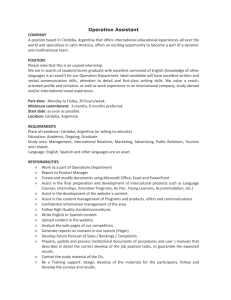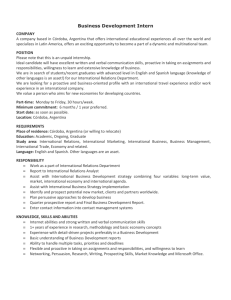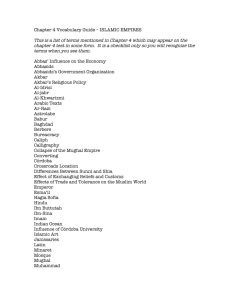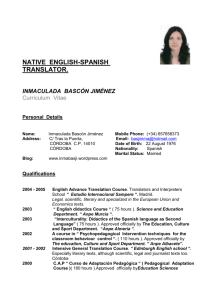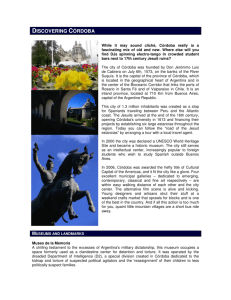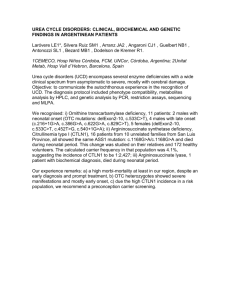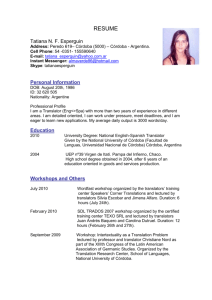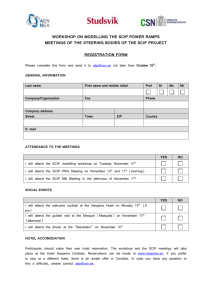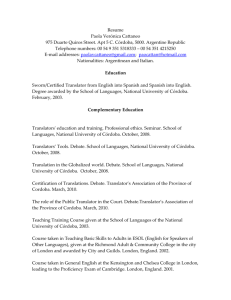Objective and Content
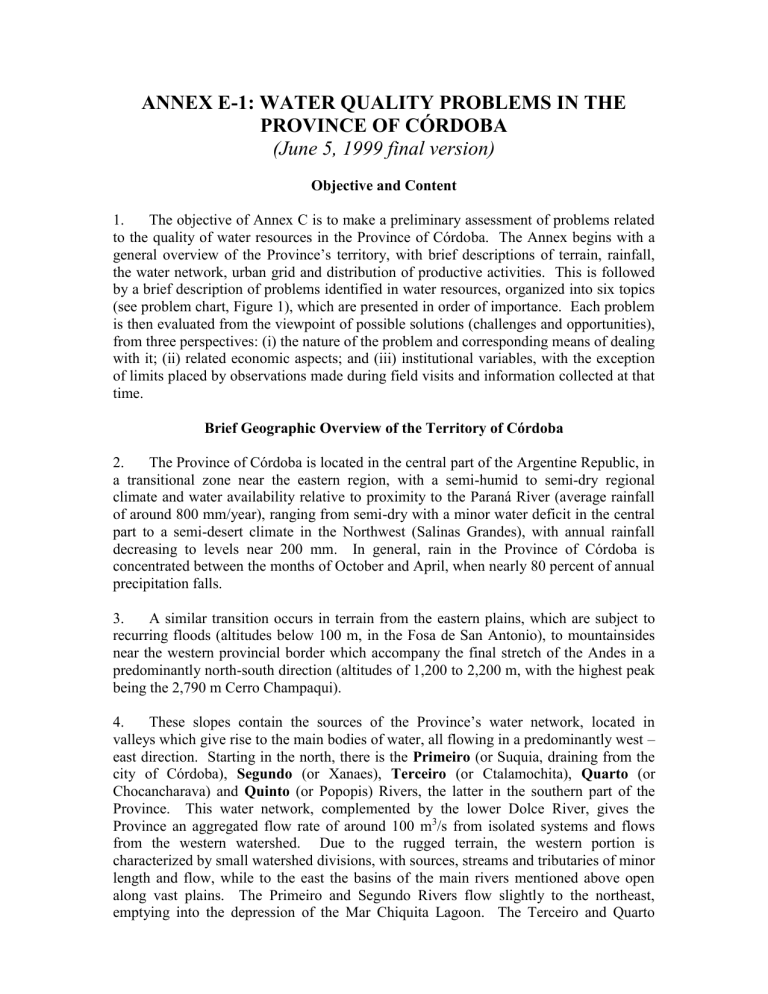
ANNEX E-1: WATER QUALITY PROBLEMS IN THE
PROVINCE OF CÓRDOBA
(June 5, 1999 final version)
Objective and Content
1. The objective of Annex C is to make a preliminary assessment of problems related to the quality of water resources in the Province of Córdoba. The Annex begins with a general overview of the Province’s territory, with brief descriptions of terrain, rainfall, the water network, urban grid and distribution of productive activities. This is followed by a brief description of problems identified in water resources, organized into six topics
(see problem chart, Figure 1), which are presented in order of importance. Each problem is then evaluated from the viewpoint of possible solutions (challenges and opportunities), from three perspectives: (i) the nature of the problem and corresponding means of dealing with it; (ii) related economic aspects; and (iii) institutional variables, with the exception of limits placed by observations made during field visits and information collected at that time.
Brief Geographic Overview of the Territory of Córdoba
2.
The Province of Córdoba is located in the central part of the Argentine Republic, in a transitional zone near the eastern region, with a semi-humid to semi-dry regional climate and water availability relative to proximity to the Paraná River (average rainfall of around 800 mm/year), ranging from semi-dry with a minor water deficit in the central part to a semi-desert climate in the Northwest (Salinas Grandes), with annual rainfall decreasing to levels near 200 mm. In general, rain in the Province of Córdoba is concentrated between the months of October and April, when nearly 80 percent of annual precipitation falls.
3. A similar transition occurs in terrain from the eastern plains, which are subject to recurring floods (altitudes below 100 m, in the Fosa de San Antonio), to mountainsides near the western provincial border which accompany the final stretch of the Andes in a predominantly north-south direction (altitudes of 1,200 to 2,200 m, with the highest peak being the 2,790 m Cerro Champaqui).
4.
These slopes contain the sources of the Province’s water network, located in valleys which give rise to the main bodies of water, all flowing in a predominantly west – east direction. Starting in the north, there is the Primeiro (or Suquia, draining from the city of Córdoba), Segundo (or Xanaes), Terceiro (or Ctalamochita), Quarto (or
Chocancharava) and Quinto (or Popopis) Rivers, the latter in the southern part of the
Province. This water network, complemented by the lower Dolce River, gives the
Province an aggregated flow rate of around 100 m 3 /s from isolated systems and flows from the western watershed. Due to the rugged terrain, the western portion is characterized by small watershed divisions, with sources, streams and tributaries of minor length and flow, while to the east the basins of the main rivers mentioned above open along vast plains. The Primeiro and Segundo Rivers flow slightly to the northeast, emptying into the depression of the Mar Chiquita Lagoon. The Terceiro and Quarto
Annex E-1:
Water Quality Problems In the Province Of Córdoba
Rivers, the latter after passing the Bañados del Saladillo, meet to form the Carcarañá
River. Table 1 presents data on area and annual availability of the these watersheds:
Table 1: Principal Watersheds
Watershed Area (km 2 ) Annual Flow (Hm 3 )
Primeiro River
Segundo River
Terceiro River
1,350
980
3,300
284
309
854
Quarto River
Quinto River
1,450
4,500
145
137
Source: Gianoni, Marta Elena Mercado de, Scholarship Subject: Evolution of
Legislation on Water Resources in the Province of Córdoba (1994)
5.
To handle water use demands, the Province of Córdoba stores a volume of 1,540
Hm
3
in reservoirs. A large part of this is for power generation in the Terceiro River (560
Hm 3 ), the Los Molinos dam on the source of the Segundo River (307 Hm3), and for the
San Roque reservoir (201 Hm
3
), a supply source built on the Primeiro River upstream from the city of Córdoba 1
.
6.
Regarding spatial distribution of the Province’s population, with the exception of
Greater Córdoba there is a large rural population (820,000 people), which is equivalent to
29 percent of the 2.76 million total inhabitants (1991). A significant number
(approximately 450,000 inhabitants) also live in countless small cities and communities.
7. Thus, the urban network is marked by the central location of the city of
Córdoba
, whose population exceeds 1,179,372 inhabitants (1991). This is followed by the
Province’s central zone with another 10 population centers of between 10,000 and 41,000 residents, located mainly in the departments of
Colón
, with 77,000 inhabitants in the north, Punilla , with 72,000 inhabitants in the west (including Villa Carlos Paz, with
41,000 residents at a water source of interest to the city of Córdoba), and
Segundo River and
Santa María
(16,000 and 37,000 inhabitants, respectively). Moreover, in Greater
Córdoba’s central zone of influence (80 km radius), there are another 16 centers with populations ranging between 2,000 and 10,000 (aggregate total of 83,000 inhabitants), as well as 54 communities (population centers with fewer than 2,000 residents) totaling
27,000 people.
2
8.
With regard to production, the city of Córdoba’s central location makes it a prime industrial site. Of particular note is its automotive park and respective chain of suppliers.
It is also worth noting the existence of significant industrial factories, as well as the harnessing of hydroelectricity in the upper part of the Terceiro River basin. Extensive agricultural crops are developed along Córdoba’s eastern border on the plains near the place where the middle and lower stretches of the Terceiro and Quarto Rivers join to
1 Gianoni, Marta Elena Mercado de, Scholarship Thema: Evolution of Legislation on Water Resources in the Province of Córdoba, mimeograph, Catholic University of Córdoba (1994).
2
Strategic Plan for the City of Córdoba – PEC (1996)
2
Annex E-1:
Water Quality Problems In the Province Of Córdoba form the Carcarañá River, on a strip formed from the northern to southern part of the
Province.
9. Irrigated areas total around 60,000 Ha, including 700 km of primary, secondary and tertiary canals, of which about 20 percent are lined. The principal irrigation systems are those of the Primeiro River, with canals north and south of the city of Córdoba, and that of Cruz del Eje, with damming prior to infiltrations from bodies of water in the region of
Salinas Grandes in the northwest of the Province. Groundwater is used separately by farmers to complement surface water, but no information is available on the amounts of groundwater extracted or on the capacity and conditions of aquifers to be recharged, which could result in scenarios of future shortages.
P ROBLEM 1: S HORTAGE OF W ATER R ESOURCES IN THE N ORTHWEST
(S
ALINAS
G
RANDES
)
10. The Salinas Grandes are a flat depression with minimal slope, between mountains in the northwest of the Province near the border with Catamarca. The rivers flowing into this region (Cruz del Eje, Soto and Pichanas) filter and feed the water tables. The total area of tributary basins exceeds 2,100 km
2
, with available flow limited to 64 Hm
3
per year. However, there is little information on the actual availability of water resources in this region, which is marked by seasonal precipitation averaging a little over 200 mm, and by the presence of high levels of salinity in groundwater.
11. A problem of economic depression stems from such natural conditions, which requires the possibilities of regional development to be adjusted to compensate for seasonal climate conditions. Despite other alternatives, the high costs of providing the region with water transfer infrastructure constitutes a limiting factor and calls for restricted options, the expansion of which will be quite dependent on compensatory mechanisms made available either by the Central Government or by the Province.
P ROBLEM 2: S EASONAL N ATURE OF W ATER R ESOURCES IN THE
R
IVER
B
ASIN
Q UINTO
12. The sources of the Quinto River lie in the Province of San Luis, to the west, which follow a southeasterly direction until emptying into the lagoons and wetlands of La
Amarga, in Córdoba, 110 km from the border. Due to low precipitation in its western sources and to seasonal climate problems, the Quinto River faces problems of prolonged drought when wetlands turn into dry stubble fields ( pajonales ), or of floods that spread due to the flatness of La Amarga’s lands.
13. There is no information on studies aimed at providing for greater regularity of flow rates, to reduce flooding and mitigate the effects of droughts. It should be noted, however, that such challenges must necessarily be linked to the interprovincial management of this river basin, which is shared by San Luis and Córdoba. In terms of possible economic potential, it should be recognized that these areas are not well linked to the dynamic centers of the Province of Córdoba, either in terms of industrial location
3
Annex E-1:
Water Quality Problems In the Province Of Córdoba or agricultural production, even though the regional road network circles southern
Córdoba, linking San Luis and Mendoza.
P
ROBLEM
3: F
LOOD
C
ONTROL AND
S
ILT
R
UNOFF IN THE
Q
UARTO
R
IVER
B
ASIN a) Definition of the Problem
14. The sources of the Quarto River lie on the steep slopes along the borders of western
Córdoba. It flows southeast until reaching the plains, where it has much lower slopes, low drainage velocity and little natural flood retention, which are characteristics of the territory’s vast size, particularly in the southern part of this river basin (bordering on the
Quinto River basin near the streams of Santa Catalina, El Gato, Sampacho, Las
Cortaderas and others). As these floods spread, they affect neighboring Provinces and are favored by the depression of the Fosa de San Antonio, when water tables increase during periods of heavy precipitation. At mid-course, the Quarto River feeds the wet lands of the Bañados del Saladillo, the name it keeps until it meets the Terceiro River to form the Carcarañá River, which flows in the direction of the Province of Santa Fé on the eastern border of Córdoba.
15. Extensive farming is predominant in the basin, carried out with little concern for soil management or planting on level curves, due to the few slopes there. This results, first, in a relative acceleration of surface runoff, which is facilitated by furrows made in the soil for planting, and which amplifies flooding by reducing the time for concentrating and directing rural runoff flows.
16. At the same time, greater runoff speed facilitates the carrying off of soils, with negative consequences for the quality of surface water, both in terms of solids in suspension associated with the loss of upper layers of fertile soil, and the consequent need for greater use of agricultural inputs (fertilizers and pesticides). This fact can be verified by the probable increasing presence of nitrogen and phosphorus in bodies of water.
17. On this subject, as an example of the general situation of developing countries, existing data is insufficient to establish correlating factors among levels of nitrogen, phosphorus and even solids in suspension with geophysical and hydraulic features in the basins in question. It should thus be noted the above statements on causes and effects are predominately speculative.
18. Groundwater, in turn, is used separately by farmers who drill wells, by the rural population, and to complement surface water in supplying communities. It should be noted, however, that data available from the Province of Córdoba’s Ministry of Health 3 indicate the presence of arsenic in these water tables is higher than the acceptable level of 0.05 mg/l. These concentrations increase towards the plains in the eastern part of the
Province (in the lower stretches of the Quarto, Segundo and Primeiro Rivers), with values
3
1997
4
Annex E-1:
Water Quality Problems In the Province Of Córdoba ranging from 0.08mg/l in the Quarto River basin to extreme levels of 0.13 mg/l in the
Department of Marcos Juarez and of 0.18 mg/l in San Justo
4
. b) Problem-Solving (Challenges and Opportunities)
19. The challenges and opportunities concerning the above-mentioned problems are related to the organization of rural extension programs for the dissemination of microcatchment management practices, according to examples already financed by the
World Bank in other countries of the region. Along with reducing the speed of surface runoff and serving to control floods through aggregated retention of water flows in each microcatchment, planting on level curves tends to maintain the soil’s surface layer, and consequently the inputs that were applied to it. This, in addition to longer-term economic benefits, justifies such rural extension programs in financial terms.
20. With more specific regard to flood control, there may be a need to build successive small dams on rural properties to hold back part of the non-filtrated excess water and to help farmers develop complementary economic activities. In terms of water quality, such actions will result in reduced incremental indices of solids in suspension, nitrogen and phosphorus.
21. Inter-institutional linkage between agricultural development agencies and environmental control agencies should be foreseen and considered by the abovementioned program, and take on a key role. In the context of the program implemented in the State of Paraná, the enactment of legislation containing the necessary enforcement to encourage farmers to adopt such practices is worth noting, as is the necessary lines of credit to finance management actions and the installation of proposed small rural dams.
22. Finally, these programs must include the installation of a proper network to monitor bodies of water (with hydro-meteorological and water quality data), and inspect producing agents so that monitoring and results assessment indicators can be established, foreseeing the ongoing operation of the installed network by competent agencies upon completion of the programs.
P ROBLEM 4: T REATMENT OF I NDUSTRIAL W ASTE ; P OWER G ENERATION AND
P
UBLIC
S
UPPLY FROM
T
ERCEIRO
R
IVER a) Definition of Problem
23.
Replicating the typology of the main bodies of water in the Province of Córdoba, the sources of the Terceiro river lie on the high slopes in the west, where the Santa Rosa,
Amboy stream, Grande, Quillinzo and Sauces – La Cruz Rivers meet, all of which directly flow to the Terceiro River dam. Thereafter, the Terceiro river flows first to the east, then to the southwest, until it empties into the formation of the Carcarañá river.
4
Medeiros, Katia (FAO), Water Supply System in The Province Of Córdoba , paper edited by Musa Asad
(IBRD - 1998).
5
Annex E-1:
Water Quality Problems In the Province Of Córdoba
This river basin is individually responsible for the Province’s major surface water availability, corresponding to an average flow rate of 27 m
3
/s, around 30 percent (thirty percent) of the total.
24. In view of this availability, there are multiple uses of water from the Terceiro
River, characterized: (i) in its upper and middle stretches by power generation (5 power plants) and the presence of complexes linked to the petrochemical and military industries, including a nuclear power plant using intakes (low consumptive uses) and draining effluents; (ii) in its middle and lower stretches by intakes to supply a population of around 55,000 inhabitants in cities and communities in the southeastern region; and (iii) in its lower stretch, near the Carcarañá river, by extensive irrigated crops, carried out along the eastern border of Province, as previously mentioned in characterizing activities in the Quarto River basin.
25. In terms of its spatial location, water availability in the Terceiro River, in addition to its proximity to the main regional transportation routes—especially from the highway junction at Villa María (midway) toward Rosario and Greater Buenos Aires—give this river basin strategic importance among regional development alternatives. It is reasonable to foresee that future industrial development will occur between the city of
Córdoba and the nation’s capital. This coincides with the installation of the automotive park of Greater Córdoba, south of the city.
26. Despite multiple and regionally well-distributed uses, water problems in the
Terceiro River appear to be concentrated from industrial pollution of petrochemical and military complexes installed along the middle and upstream portions, possibly from before the environmental requirements stipulated by current legislation could be imposed.
These problems affect the possibilities of upstream use, especially human supply. b) Problem Solving (Challenges and Opportunities)
27. There is no lack of legal instruments to settle problems. First, there is a profusion of regulatory instruments, many of which overlap and are extremely demanding, but all of which lack the means to be effectively applied. This lack is due either to weakness of responsible institutions (from an absence of basic information, technical instruments and staff, and professional motivation), or to a lack of even minimal levels of interinstitutional linkage, particularly concerning environmental and water resources management, which is even separated in ranking on the provincial administration’s general organizational chart.
28. Thus, industrial pollution problems in the Terceiro River could be mitigated as available command and control instruments are applied before requiring sophisticated
(and sometimes costly and ineffective) management instruments such as the installation of a Watershed Committee; however, it will likely be necessary to establish a feasible timetable of industrial investments to pre-treat waste and rationalize productive processes that use water as an input, making standards stipulated in current legislation flexible so
6
Annex E-1:
Water Quality Problems In the Province Of Córdoba that the objectives of abating pollution loads can be negotiated and implemented realistically.
29. In summary, current conflicts regarding the Terceiro River, which underlie both present and potential future conflicts, do not appear sufficient to sustain the greater institutional sophistication which has already been pursued in various Argentine river basins. There is also a notable lack of an economic base to support the decision-making process on the use of water resources, either in the short term, with a preponderance of industrial pollution problems, or (especially) for outlining future scenarios, when the current situation could be worsened by effective disputes over multiple water uses.
30. There are three relevant points here. First, it is worth repeating the need for greater rationality in the environmental licensing process. This not merely a matter of conferring feasible bases (both economic and financial) for legal requirements, as mentioned above.
Duplications and internal contradictions must be avoided, overcoming, for example, the possible conflict of interest present in the preparation of environmental studies. These studies are the subject of the “Regulation on the Environmental Impact Assessment”
(Decree No. 3290), and are contracted and conducted by the entrepreneurs themselves, despite its (sometimes formal) review and subsequent approval by the Provincial
Environmental Council
5
.
31. The isolated treatment of these businesses, even though they are geared towards environmentally suitable production and avoid the defect in the beginning of the process
(as mentioned above) does not provide for local-level decision-making instruments involving water availability (water is the planning factor for the territory) since it does not consider the aggregate loads already installed nor the receiving capacities of bodies of water as a mandatory element of analysis. Thus, paradoxically, various industries may be legally licensed in a particular river basin—even effectively dumping loads in accordance with their emissions licenses—despite the fact that these bodies of water are jeopardized since their flow and purification features may be incompatible with aggregate dumping.
32. These observations lead to the second point. No water resources management will be carried out without a minimum basis of information which should include proper cadastres of water uses and users, and data of the pluviometric, hydrometric and water quality network. These should be submitted for proper processing to contribute to decision-making support tools, including hydrodynamic models.
6
This concern should also cover the use of underground aquifers, not only in light of natural contamination by
5
The recent enactment of the “Rules for the Protection of Surface and Ground Water Resources” (Decree
No. 415, dated 12/April/1999) reproduces the extremely strict requirements for obtaining grants with gaps remaining between Command and possibilities for Control . Note the exception of undertakings installed in Córdoba, where a supplementary effort by the City’s Secretariat of the Environment, with more available resources, is trying to fill some of the gaps identified in the process.
6
Information collected from the Bureau of Water and Sanitation (DAS), Department of Water resources, indicates about 40 pluviometric posts operating in the Province and an undetermined number (fewer than
70) of flow measurement stations. As an exception, records on water quality data collection are kept by the Secretariat of Environment of the City of Córdoba, involving OD, DBO, N and F, with analyses performed at its own laboratory.
7
Annex E-1:
Water Quality Problems In the Province Of Córdoba arsenic, fluorides and salts, but also to check their recharge velocity and effective potential.
33. Finally, an analysis of the alternative of using the Terceiro River as a source of public water supply should first be made. With regard to cities and communities in the southeastern region, about 55,000 inhabitants are served by an aqueduct that is currently being expanded with provincial funds of the Bureau of Water and Sanitation (DAS). For this population, intake demands may be estimated at no more than 250 l/s, a modest flow rate compared to the Terceiro River’s availability in its middle and lower stretches. No problems are anticipated except those of the quality of water contaminated by upstream industrial complexes. With regard to the city of Córdoba, which lies quite a distance from the Terceiro River, consideration should be given to concerns about maintenance of nearby sources (Primeiro and Segundo Rivers), whose potential is far from depleted, provided that pollution problems (dealt with in this Annex) are duly settled.
P ROBLEM 5: C ONSERVATION AND U SE OF THE S EGUNDO R IVER AS A W ATER
S OURCE FOR G REATER C ÓRDOBA
34. The Segundo River arises from the confluence of numerous small watersheds lying on the slopes of western Córdoba which are the origin of its main body, the Los Molinos
River, where an important dam was installed (307 Hm
3
reserve). The Los Molinos is named Segundo after meeting the Anizacate River, downstream from the town of Los
Despeñaderos. From there, it flows in a predominantly northeasterly direction until it empties into the depression that gives rise to La Laguna Mar Chiquita, about 70 km from the border with the Province of Santa Fé, in the east.
35. Today, nearly thirty percent (or somewhat less than 2 m
3
/s) of flows collected to supply Greater Córdoba, are transposed from Los Molinos reservoir, whose water quality should, in principle, be better than that of San Roque (see next chapter), and which constitutes an alternative to meet future demands. However, it should be noted that the results of the monitoring program, conducted by the Provincial Scientific Laboratory
(CEPROCOR), indicated the presence of high levels of thrihalomethanes (average variations of 80 to 200 mµ/l, with a recommended limit of 100 mµ/l) resulting from reactions of organic material present in intake waters (toxic blooms of cyanobacteria ) with chlorine added for drinking water.
7
36. Since urban centers upstream from the reservoir are new, as are crop activities that might need fertilizers, water quality problems in Los Molinos and sources of the Segundo
River may possibly stem from natural conditions, which increase the need for actions and care regarding its conservation. In any case, due to limited data and specific studies on this reservoir, it is recommended that monitoring campaigns be carried out until the
7
Medeiros, Kátia (FAO); it is worth noting the observation that the concentration of thrihalomethanes usually increases with distance and the time it remains in the treated water distribution system, which could indicate even higher levels at intermediate reservoirs and therefore in households.
8
Annex E-1:
Water Quality Problems In the Province Of Córdoba relationship of cause and effect on the above-described results is understood with greater certainty.
37. Downstream from Los Molinos, beginning at the middle stretch of the Segundo
River and especially after it spreads out on the plains near La Laguna Mar Chiquita, water quality problems become similar to those found in the Terceiro and Quarto Rivers, meaning the presence of arsenic, fluorides and salts, especially contaminating the water tables. In these stretches, however, demands are low for irrigation and supply to the small resident population.
38. To conclude the definition of problems in the Segundo River, one of the vectors of industrial expansion in Greater Córdoba is towards the south (as previously noted). This could advance, in the future, onto a stretch of the land of this river basin downstream from Los Despeñaderos, repeating the issue of industrial waste disposal present in the
Terceiro River. For this possibility, the same observations contained in paragraphs 27 to
32 apply, concerning the effectiveness of Command and Control instruments stipulated in current legislation.
P
ROBLEM
6: (6.1) W
ATER
P
OLLUTION IN
S
AN
R
OQUE
L
AKE
(6.2) U RBAN E NVIRONMENT OF THE C ITY OF C ÓRDOBA a) Primeiro River Basin
39. In accordance with the typology common to other bodies of water in the Province, small watersheds lying on the slopes of western Córdoba give rise to the Cosquín
(average flow rate of 4.5 m
3
/s) and San Antonio (average flow rate of 5.5 m
3
/s) Rivers, the main tributaries of San Roque Lake, into which the Chorrillos River also empties
(although with a lesser flow). This reservoir—built about 35 km upstream from
Córdoba—constitutes, as the source of the Primeiro River, both the main water source for
Greater Córdoba (70 percent of demand or 5 m 3 /s ) and a regional recreation area, due to its great natural beauty and strong potential for tourism (1.750 km
2
surface area).
40.
Upstream from Córdoba, an additional
5 m 3 /s of water from the Primeiro River are drawn to feed irrigation canals that go to the north and south along the border of the urbanized area for vegetable production aimed at consumers in the capital. In the recent past, the significant inclines in this initial stretch favored power generation on the
Primeiro River, now reduced to a small-scale power plant.
41. After Greater Córdoba, the Primeiro River passes through the eastern plains until it empties into winding streams in the depression of La Laguna Mar Chiquita, following a course and natural conditions nearly parallel to those of the Segundo River. b) Definition of Problems in San Roque Lake
42. The ascertainment of cyanobacteria in the reservoir, as well as of thrihalomethanes in (principally) the Upper Alberde Water Treatment Plant (average
9
Annex E-1:
Water Quality Problems In the Province Of Córdoba variations of 40 to 200 mµ/l, with a recommended limit de 100 mµ/l) 8
, arises directly from the urban settlement process around the reservoir, which is the product of its attraction for tourism, exercised in the regional sphere. Table 2 below lists the set of cities and communities that developed along the the regional roads built in valleys along the Cosquín, San Antonio and Chorrillos Rivers, with the respective populations and annual growth rates observed from 1980-91. In addition to the data presented, it should be added that growth rates have been higher in the 1990s, with a significant seasonal fluctuation in population. There are around 13,794 leisure homes in neighboring areas, and a potential of up to 62,000 additional residents during peak season.
9
Table 2 – Cities and Communities Contributing Directly to San Roque Lake
River Basin Cities and Communities Population
(1991)
Average
Rates (80-91)
Growth
Cosquín River
Chorrillos River
San
River
Antonio
- Cosquín
- Santa María
16.866
6.119
- Bialet Massé 2.338
- V. Sta. Cruz Del Lago 863
- San Roque 364
- Villa Parque Siquimán 447
- Tanti 3.323
- Estancia Vieja
- Villa Carlos Paz
318
40.912
- Cabalango
- San Antonio
- Tala Huasi
- Mayu Sumaj
- Cuesta Blanca
- Icho Cruz
63
703
37
560
151
646
1,91
0,93
2,98 s/d (3)
S/d
S/d
S/d
S/d
S/d
S/d
S/d
S/d
4,40
S/d
3,09
TOTAL (1) 73.710 hab. (2) -
Note: (1) The total population in the basin contributing to San Roque is 103.794 inhabitants (1991).
10
(2) Updated projections indicate a current population of up to 100.000 inhabitants.
(3) s/d = no data available.
43. Two types of problems occur from the location of these urban centers in the basin contributing directly to the Lake. The first pertains to cities with a larger population and density (particularly for Villa Carlos Paz), several of which have some service from sewage collection networks but no sewage treatment. The second is associated with the technical and financial difficulties of providing services to the scattered population for which, due to the lack of concentration, conventional sewer drainage systems do not apply.
8
Medeiros, Katia (FAO), report cited, with monitoring data collected by CEPROCOR.
9
Manfrand, Graciela, Elements of Conflict for an Institutional Structure Proposal for the Environmental
Management of the San Roque Lake Watershed – Territorial, Institutional and Environmental
Diagnostic , Institutional Environmental Development Program – PRODIA, July – October 1998.
10
Ibdem, doc. cited .
10
Annex E-1:
Water Quality Problems In the Province Of Córdoba
44. In both cases, natural downsloping and soil conditions contribute negatively to worsen the pollution problem. San Roque Lake, with an average depth of only 13 m , lies between steep slopes to the east (altitudes of 1,200 m), even though these have some plant cover, and even steeper (though less accentuated) slopes to the west (up to 2,200 m), with only incipient vegetation. In both watersheds, soil has a rocky substratum with shallow depths, appearing on banks to the west of the reservoir.
45. By reducing concentration times and possibilities for filtration, these natural conditions contribute to other sources of pollution associated with rudimentary agricultural practices (without soil management), slash-and-burn of plant cover, as well as disposal of solid waste (trash) in small creeks and streams, or even at the banks of the reservoir (noted during field visits). With regard to the occurrence of more intense rains, surface runoff contributes additional sediments and nutrients to San Roque Lake.
46. Initial academic studies performed in the reservoir made data available to quantify the situation described above.
11 Countless water samples collected in different parts of the reservoir allowed analyses to be made of physical-chemical and microbiological parameters (OD, DBO, DQO, phosphates, nitrates, nitrites, solids in suspension, total and fecal coliforms and salmonella, among others).
12
Obtained results indicated higher concentrations of nitrogen and phosphorus in the lake’s water and sediment than those recommended by international agencies. Paradoxically, DBO results were lower than expected, which might indicate only a small organic load in the lake; according to experts, this could be “from the greater difficulty in applying tests on a sheet of water where microbial oxygen is proportionate to the carbon remaining in the final carbonaceous stage of DBO.” 13
47. Despite the DBO results, Part II of the studies, which dealt with histological lesions in teleostean fish attributable to organic pollution, confirms repercussions stemmed from high levels of nitrogen and phosphorus in the waters of San Roque Lake, as well as the presence of cyanobacteria , mentioned in paragraph 42. c) Definition of Problems in the Urban Environment of the City of Córdoba
48. It appears evident that the details described above have repercussions on water supply to the City of Córdoba, at least implying higher costs for drinking water
(transferable to tariffs) and, more seriously, the potential (as warned) of thrihalomethanes generated from reactions between cyanobacteria and elevated doses of chlorine. Even though these water supply services are under the private responsibility
11
Morvillo Verónica et. alli, Study of Bioecological Features of San Roque Lake, Villa Carlos Paz,
Province of Córdoba, Parts I and II, Sanitary and Environmental Engineering No. 37 (April/1998) and No. 38 (August/1998).
12
Ibdem , Tables I to IV, pgs. 32 to 35, doc. cited.
13
Ibdem , pg. 36, doc. cited .
11
Annex E-1:
Water Quality Problems In the Province Of Córdoba of Aguas Cordobesas
14
through concessions from the Provincial Government, residents in Córdoba must understand that water consumed during the week contains their own liquid waste dumped into San Roque on Sundays, and a more significant volume on holidays and in the summer. This is a relevant problem.
49. Moreover, with specific regard to the City of Córdoba, there are typically urban environmental issues related to the phenomenon of heat inversion during the winter, caused by the convergence of low temperatures and humidity, for which the municipal government has made efforts to rationalize traffic and reduce vehicular circulation on the narrow streets of the City’s historic center.
50. With regard to solid waste, services appear to be well balanced, serving nearly ninety five percent of the population of Córdoba (some even with selective collection), as well as Alta Gracia and Los Despeñaderos, where the controlled Sanitary Landfill is located and privately operated at the Provincial Capital’s expense, at a complex that includes an incineration plant for hospital waste.
51. Mention should be made here of the good structure of the Secretariats dealing with these issues: Urban Development (responsible for the preparation of the PEC – Strategic
Plan for the City of Córdoba) and Environment, the latter of which has its own laboratory and network of environmental indicators (including water quality data). Both have experienced, qualified staff which allows the City to complement and fill gaps observed in the performance of provincial agencies responsible for water and environmental issues.
52.
These qualifications reflect the Municipality’s environmental control over its
2,470 industries (predominantly metal-mechanical products and foodstuffs), 49 of which are of medium and large size,
15
including units in the automotive park which were installed more recently (Chrysler, Volkswagen and Fiat), and respective second- and third-level suppliers. On this subject, it is worth mentioning that the efforts of the Secretariat of
Environment of the City of Córdoba make it possible to have environmental feasibility studies to complement those mentioned in paragraph 30 of this Annex (p. 7), after which the proper municipal adjustment and subsequent operation of these enterprises can then be carried out.
53. However, several observations should be made concerning the provision of sanitary sewage collection and treatment services. These services reach forty-seven percent of residents in Córdoba, and are provided directly by the City Government, which operates its own Secondary Treatment Station south of the urban area. Theoretically, the costs
(including investments) are sustained by municipal taxes, particularly urban charges
(building and land tax, lighting taxes, trash collection and street cleaning), defined
14
International consortium with a majority (29 percent) ownership by the French company Lyonnaise d’Eaux, for a 30-year concession restricted to provision of treated water, which calls for an Investment
Plan that could reach US$100 million in 5 (five) years, of which US$30 million is shareholder contribution, US$45 million is credit from the European Investment Bank and the balance is from its own funds.
15
Companies with over 250 (two hundred and fifty) employees.
12
Annex E-1:
Water Quality Problems In the Province Of Córdoba proportionately for constructed and undeveloped areas, with the taxes collected forming part of the municipality’s general revenue.
16
54. Although the expansion of these services has been observed (from 13 percent in
1978 to the current 47 percent), particularly in recent years, the issue is the absence of clear economic incentives so that important investments can be made to increase indices of sanitary sewage collection and treatment, either from the restricted perspective of financial tax collection (services as a profitable business), or from a broader economic and environmental standpoint since potential beneficiaries of these investments are the scattered, small populations downstream from Córdoba. It appears evident that the
Municipality of Córdoba is in a rather comfortable position to transfer revenues associated with sanitation services, according to its own reading of priorities.
55. Issues such as these, however, may take on increasing importance as Córdoba begins to face a recurring problem of other Latin American urban centers: improper settlements , promoted by low-income inhabitants, in risky or unsuitable areas for urbanization. In the case of Córdoba, this location is principally along the banks of the aforementioned irrigation canals that encircle the City to the north and south.
56. Thanks to the attraction of its automotive park, migrant populations—including
Paraguayan and Bolivian families—have flocked to Córdoba in search of jobs and income, but they lack the qualifications needed for such jobs. The by-products of these jobs are well-known and constitute a serious, complex urban environmental problem: increased population density, difficult access and traffic, lack of basic sanitary infrastructure, direct contact with bodies of water used for final disposal of liquid and solid waste, and matters of social marginalization and insecurity.
57. It is worth noting that the relative growth of these types of settlements have occurred despite the noted drop in annual population growth rates for the City of Córdoba
(see Table 3). Information gathered from interviews indicates that the contingent living in sub-normal urban areas rose from 3 percent to nearly 10 percent , exceeding 100,000 residents in the past decade. Of the population statistically considered poor, 47 percent live in unstable settlements.
17
Table 3 – Population Growth Rates of Greater Córdoba
Inter-Census Period 1947-1960 1960 – 1970 1970 – 1980 1980 - 1991
Average annual growth of 3.15 3.07 2.16 1.64 the Department of the percent percent percent percent
Capital (*)
(*) Greater Córdoba includes: Córdoba, Villa Allende, Rio Ceballos, Unquillo, Salsipuedes, Sáldan and
Mendoliaza.
Source: City of Córdoba / Statistical Guide to Production and Services (1996).
16
According to information collected from interviews, it is estimated that residences measuring 150 m 2 contribute for these services an average monthly amount of US$10.00 (ten dollars), bringing municipal coffers an annual revenue of slightly than US$20 million.
17
PEC, doc. cited .
13
Annex E-1:
Water Quality Problems In the Province Of Córdoba
58. In view of this type of urban problem, not only the supply of sanitation services, but also principally their financing matrix (cross-subsidies among classes of consumption and income, and among regions – center/outskirts) and compensatory policies will now form part of the agenda of priorities in Córdoba. d) Solving Problems in San Roque Lake (Challenges and Opportunities)
59. Engineering of Solutions.
To reduce eutrophication of San Roque Lake, it will be necessary to implement a program with integrated actions for water quality recovery and environmental protection in the reservoir , carefully contemplating not only the disposal of sewage, but also the collection and disposal of solid waste, the recomposition of plant cover, fire control and dissemination of proper agricultural soil management practices.
60. The principal component of sanitary sewers should seek the interaction of two types of solutions. First, in areas of greater density (Villa Carlos Paz and nearby areas), a conventional system of waste water collection and treatment should be installed, and it should be expanded towards vectors of human settlement. Conventional systems, whether isolated or joint, should also be implemented in Cosquín, Santa María and Bialet
Massé (lower basin of the Cosquín River). The technical challenge will be the establishment of zones circling the system(s), to be defined in terms of their financial viability. As urban density decreases, individual, diverse treatment alternatives should be considered, other than the simple septic tanks and cesspools now existing in most dwellings and isolated communities, which are unsuitable for the rocky substratum and the above-described steep slopes.
18 In this second option, it will be essential for cities and communities to accept and effectively enforce the application of the “norms” proposed for individual treatment (note 15) in their respective legal regulations, setting in motion a process of progressive improvement of conditions caused by the filtration of effluents into soil.
61. Studies already available for conventional systems indicate investments that vary, according to alternatives, from US$93,000,000 to US121,000,000, plus corresponding annual operating expenses estimated between US$1,000,000 and US$2,300,000.
19
These amounts appear high at first glance, due to the preponderance of limited concepts on systems engineering, without properly checking financial viability, compared to the above-mentioned alternatives of individual treatment which are quite relevant when one considers the scattered settlement of the watershed in question
20
.
18
Regulations on Sewage Treatment in Individual and Collective Housing – San Roque Lake Watershed –
Province of Córdoba , Institutional Environmental Development Program – PRODIA, December
1998.
19
Giménez, Juan Carlos, Report of the Institutional Environmental Development Program – PRODIA,
Annex I, “Application of Multi-Criteria Methodology en the San Roque Lake Watershed” , May/1998.
20
The interesting work of Giménez (1998) is applied for selection among various studies already carried out on the engineering of possible sanitary sewer systems (DAS, Betchell International Inc. and
PRODIA – Ing. Miguel A. Potel Junot).
14
Annex E-1:
Water Quality Problems In the Province Of Córdoba
62. Economic Variables.
Whatever the relative composition of both of these sanitary solutions (individual disposal or conventional, collective systems), it should be stressed that the principal beneficiaries of the proposed integrated program will be the residents of the City of Córdoba. Therefore, the arbitrary cut in PRODIA’s area of studies, 21 limited to the contributing basin upstream from the reservoir, does not allow the specification of economic benefits directly affecting the issue of San Roque Lake.
63. Possible arguments about making upstream cities separately responsible for treating their solid waste could also be applied to Córdoba regarding the waste it dumps downstream, despite the absence of a larger number of activities and beneficiaries in the lower portion of the Primeiro River. This being said, it might be interesting at the same time to explore general concerns about (i) responsibilities for downstream environment, and (ii) possible resistance to cost distribution for the upstream protection of San Roque, carrying out research on willingness to pay for both of these objectives, and presenting it to residents Córdoba in this way.
64. Besides being illustrative, this methodological procedure could provide an economic sub-layer, currently absent, for essential negotiations among populations upstream and downstream from San Roque. These negotiations would focus on investments to be made and respective cost distribution equations, giving a new quality to the process which currently seems limited to its political dimensions and institutional volunteerism.
65. Institutional Arrangements.
Finally, some considerations are needed on the institutional arrangements n.eded to implement the proposed integrated program . The solution developed, and moreover negotiated, by PRODIA-sponsored studies appears to be a good example
22
. It is the establishment of an Inter-Municipal Community Agency for the Environmental Management of the San Roque Lake Watershed (EIMAC – SAN
ROQUE LAKE),
23
which was set up to resolve a concrete problem without the artificial features present in some previous attempts to set up Watershed Committees in Argentina.
In the present case, the establishment of EIMAC could serve as a solid foundation for the future establishment of a Watershed Committee, provided it proves effective in solving the regional problem of San Roque Lake, enabling the progressive expansion of duties assigned to it for such purpose.
66.
However, it should be noted that the City of Córdoba must be included as a participant in this management agency; otherwise, the solutions foreseen will be unstable in terms of their sustainability, since important external factors are found downstream from the basin contributing directly San Roque.
21
Documents cited in notes 8, 17, 18 and 21.
22
Proposed Institutional Structure for the Environmental Management of the San Roque Lake Watershed -
Province of Córdoba , Institutional Environmental Management Program – PRODIA, November
1998.
23
Act of Agreement, signed on February 3, 1999, by the municipalities of Villa Carlos Paz, Cosquín and
La Falda (copy provided by Ing. Bruno V. Ferrari Bono – Coordinator of PRODIA).
15
Annex E-1:
Water Quality Problems In the Province Of Córdoba e) Solving Problems in the Urban Environment of the City of Córdoba
(Challenges and Opportunities)
67. Engineering of Solutions and Economic Variables. The environmental sanitation of sub-normal urban areas (slums, illegally occupied areas and similar areas) is of course a problem with a complex solution. Initially, it requires political definitions of the level of composition, including alternatives for keeping disadvantaged populations where they are or resettling them. These definitions simultaneously include: (i) physical variables;
(ii) urban and environmental planning variables; (iii) social variables; and (iv) economicfinancial variables.
68. Physical variables (i) deal with the feasibility of installing required urban infrastructure systems and the selection of both conventional and alternative suitable technologies. They also refer to risk levels associated with the settlement of areas in question, with respect to the period of recurring floods, landslides, etc. It should be noted that, even in cases when irregular settlements are allowed to remain and are urbanized, a certain number of resettlements will take place to open up roads and other spaces needed for sanitary infrastructure.
69. With regard to urban and environmental planning (ii), care must be taken that the systems installed in irregular urbanized areas or—by the same token—the housing developments offered to resettled families “fit” properly into (or are compatible with) the general urban grid, as well as with the large infrastructure grids already installed or planned.
70. Social variables (iii) refer to concerns about the ties of family, neighborhoods or employment and income, which may be broken due to resettlements. Thus, interventions for urban environmental sanitation should always be accompanied by competent social assistance work, either for the re-adaptation of resettled families or to facilitate the physical and operational introduction of infrastructure and urban service networks.
Provisions must be made for Sanitary and Environmental Education programs.
71. With regard to economic-financial aspects (iv), broad consideration should be given to the costs and benefits involved, without overlooking, for example, the purchase of lands for resettled families, the definition of financial mechanisms or subsidies to affected populations, operational and systems maintenance expenditures, urban (and real estate) interests involving occupied areas, and consequent environmental impacts, among others. It is necessary to apply currently available methodologies to assess economic and social benefits that do not involve direct monetary expression (property prices, avoided costs or contingent assessments).
72. Institutional Arrangements.
In light of the above, urban environmental sanitation efforts may be expected to require inter-institutional linkages insofar as they encompass responsibilities assigned to different agencies. The relative complexity of necessary
Institutional Arrangements corresponds to similar problems that need to be addressed.
To mitigate inherent managerial and operational difficulties, the experiences of implementing efforts in this field seem to indicate the following scenario: integrated
16
Annex E-1:
Water Quality Problems In the Province Of Córdoba concept and centralized implementation, with a clear definition of the agent responsible for coordinating the program whose general design should be previously established.
C
OMMENTS AND
F
INAL
O
BSERVATIONS
73. It is undeniable that initiatives of a national nature, in the area of new environmental regulations, may contribute toward solving problems related to water resources observed in the Province of Córdoba.
24
However, the current predominance of a tangled set of concurrent and duplicate laws and regulations,
25
at the different municipal, provincial and national levels, reveals a legislative inconsistency common to
Latin countries, the effectiveness of which, however, is doubtful whenever environmental degradation is observed and available water is jeopardized.
74. With this in mind, in the case of the Province of Córdoba, and more broadly when one considers the structure of water resources management systems (including successful international experiences), effective solutions to analyzed problems appear to have greater dependence and potential in light of endogenous local variables. In this regard, both the challenges and opportunities of issues involving the Province’s surface and ground water sources call for the signing of local agreements as a first step and essential basis for building progressive consensus, upon which provincial water resources management may be built. The principles to be pursued are those of decentralization, flexibility and alternatives , according to which anything that can be resolved at levels closest to water users should not “go up” to higher echelons of the system.
24
Draft Law on Minimum Environmental Budgets for Water Preservation and Minimum Budget Scheme for Water Resources, both being processed.
25
Magnani, César Raúl , Outline For Legal Framework Review , May 1999.
17
Annex E-1:
Water Quality Problems In the Province Of Córdoba
References
Act of Agreement, signed on February 3, 1999, by the municipalities of Villa Carlos Paz, Cosquín and La
Falda (copy provided by Ing. Bruno V. Ferrari Bono – Coordinator of PRODIA).
Draft Law on Minimum Environmental Budgets for Water Preservation and Minimum Budget Scheme for
Water Resources, both being processed.
Gianoni , Marta Elena Mercado de, Scholarship Thema: Evolution of Legislation on Water Resources in the Province of Córdoba, mimeograph, Catholic University of Córdoba,1994.
Giménez , Juan Carlos, Report of the Institutional Environmental Development Program – PRODIA, Annex
I, “Application of Multi-Criteria Methodology en the San Roque Lake Watershed” , May, 1998.
Strategic Plan for the City of Córdoba – PEC (1996)
Magnani , César Raúl , Outline For Legal Framework Review , May 1999.
Manfrand , Graciela, Elements of Conflict for an Institutional Structure Proposal for the Environmental
Management of the San Roque Lake Watershed – Territorial, Institutional and Environmental
Diagnostic , Institutional Environmental Development Program – PRODIA, July – October, 1998.
Medeiros , Katia (FAO), Water Supply System in The Province Of Córdoba , paper edited by Musa Asad,
IBRD - 1998.
Morvillo , Verónica et. al, Study of Bioecological Features of San Roque Lake, Villa Carlos Paz, Province of Córdoba, Parts I and II,
Sanitary and Environmental Engineering No. 37 (April/1998) and No. 38
(August/1998).
Proposed Institutional Structure for the Environmental Management of the San Roque Lake Watershed -
Province of Córdoba , Institutional Environmental Management Program – PRODIA, November
1998.
Regulations on Sewage Treatment in Individual and Collective Housing – San Roque Lake Watershed –
Province of Córdoba, Institutional Environmental Development Program – PRODIA, December 1998.
18
